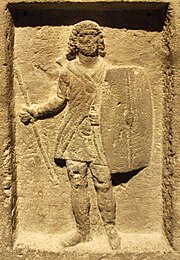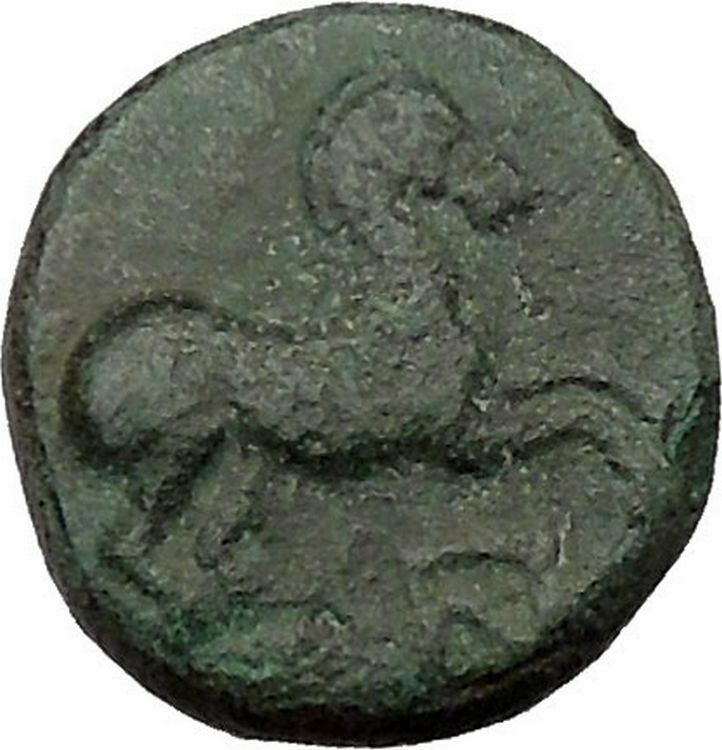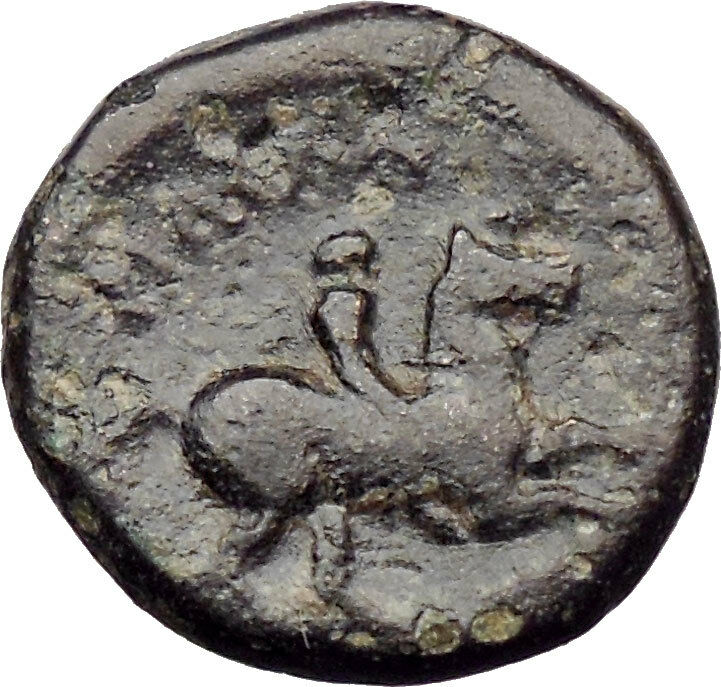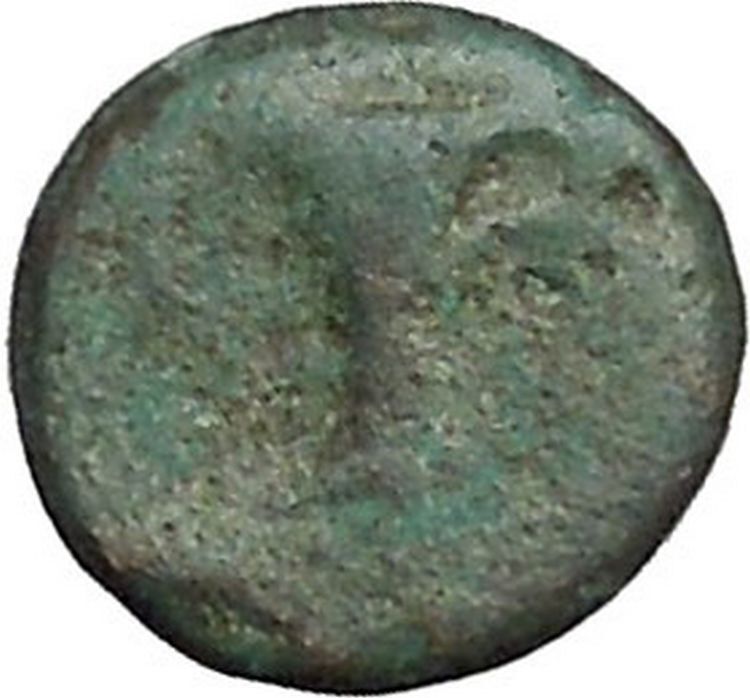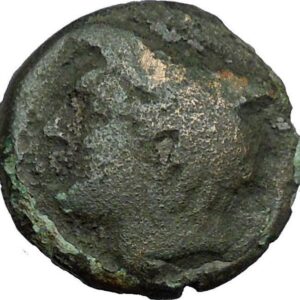|
Kingdom of
Bosporus
Rheskuporis IV – King, circa 242-277 A.D.
Bronze ‘Two Denarii’ 18mm (4.93 grams) Struck circa 244-277 A.D.
Reference: MacDonald 626
ΒΑCΙΛЄѠC ΡΗCΚΟVΠΟΡIΔ,
Bust of Rheskuporis IV right, wearing diadem.
Aphrodite Apatura (Urania) enthroned left, holding
phiale or apple;
B in field to left; in field to right, star.
The chief deity of the whole Bosporan kingdom was no
doubt Aphrodite Urania: the centre of her worship was on the east side of the
strait where she had a temple in Phanagoria and one called the Apatourou on the
south side of Lake Corocondamitis: after this sanctuary she is described in
inscriptions as Αpatourias or more often Apatorou Medousa [Minns 1913 p. 618].
You are bidding on the exact item pictured,
provided with a Certificate of Authenticity and Lifetime Guarantee of
Authenticity.
Aphrodite Urania (Ancient Greek:
Οὐρανία) was an
epithet
of the Greek goddess
Aphrodite
, signifying “heavenly” or
“spiritual”, to distinguish her from her more earthly aspect of
Aphrodite Pandemos
, “Aphrodite for all the
people”. The two were used (mostly in literature) to differentiate the more
“celestial” love of body and soul from purely physical lust.
Plato
represented her as a daughter of the
Greek god
Uranus
, conceived and born without a mother.
According to Hesiod
, she was born from the severed genitals
of Uranus and emerged from the sea foam. Wine was not used in the libations
offered to her. According to
Herodotus
, the Arabs called this aspect of the
goddess “Alitta”
or “Alilat” (Ἀλίττα or
Ἀλιλάτ).
Aphrodite Urania was represented in Greek art with a
swan, a
tortoise
or a
globe
.

Venus Urania (Christian
Griepenkerl, 1878)
The Temple of Aphrodite Urania (Greek:”Αφροδίτη
Ουρανία”) is a temple located north-west of the
Ancient Agora of Athens
and dedicated to the
Greek
goddess
Aphrodite
under her epithet
Urania
.
According to
Pausanias
, the sanctuary had a marble statue of
the deity sculpted by the ancient Greek
sculptor
Phidias
. Today, there are a few number of saved
stones on the slope of the hill beside the train tracks and near the temple of
her husband Hephaestus
.
Aphrodite is
the
Greek
goddess
of
love, beauty
, and
sexuality
. Her
Roman equivalent
is the goddess
Venus
. Historically, her cult in
Greece was imported from, or influenced by, the

cult
of Astarte
in
Phoenicia
.
According to Hesiod
‘s
Theogony
, she was born when
Cronus
cut off
Uranus
‘ genitals and threw them into the sea,
and from the sea foam (aphros) arose Aphrodite.
Because of her beauty other gods feared that jealousy would interrupt the
peace among them and lead to war, and so
Zeus married her to
Hephaestus
, who was not viewed as a threat.
Aphrodite had many lovers, both gods like
Ares, and men like
Anchises
. Aphrodite also became instrumental in
the
Eros and Psyche
legend, and later was both
Adonis
‘ lover and his surrogate mother. Many
lesser beings were said to be children of Aphrodite.
Aphrodite is also known as Cytherea (Lady of Cythera) and
Cypris (Lady of Cyprus) after the two cult-sites,
Cythera
and
Cyprus
, which claimed her birth.
Myrtles
,
doves
,
sparrows
,
horses
, and
swans are sacred to her. The Greeks further identified the Ancient
Egyptian goddess Hathor
with Aphrodite.[4]
Aphrodite also has many other local names, such as Acidalia, Cytherea and Cerigo,
used in specific areas of Greece. Each goddess demanded a slightly different
cult but Greeks recognized in their overall similarities the one Aphrodite.
Attic philosophers of the fourth century separated a celestial Aphrodite (Aprodite
Urania) of transcendent principles with the common Aphrodite of the people
(Aphrodite Pandemos).
The Bosporan Kingdom, also known as the Kingdom of the Cimmerian
Bosporus (Greek:
Βασίλειον του Κιμμερικού Βοσπόρου
Basileion tou Kimmerikou Bosporou), was an ancient state located in eastern
Crimea
and the
Taman Peninsula
on the shores of the Cimmerian
Bosporus, the present-day
Strait of Kerch
. (It was not named after the
more famous Bosphorus
beside
Istanbul
at the other end of the
Black Sea
.) The Bosporan Kingdom was the
longest surviving Roman
client kingdom
. It was a
Roman province
from 63 to 68 AD, under Emperor
Nero. The 1st and 2nd centuries BC saw a period of renewed golden age
of the Bosporan state. At the end of the 2nd century, King
Sauromates II
inflicted a critical defeat on
the Scythians
and included all the territories of
the Crimea in the structure of his state.
The prosperity of the Bosporan Kingdom was based on the export of wheat, fish
and
slaves
. The profit of the trade supported a
class whose conspicuous wealth is still visible from newly discovered
archaeological finds, excavated, often illegally, from numerous burial barrows
known as kurgans
. The once-thriving cities of the
Bosporus left extensive architectural and sculptural remains, while the kurgans
continue to yield spectacular Greco-Sarmatian objects, the best examples of
which are now preserved in the
Hermitage
in
St. Petersburg
. These include gold work, vases
imported from Athens
, coarse terracottas, textile fragments
and specimens of
carpentry
and
marquetry
.
Early Greek colonies
Pantikapeon and other ancient Greek colonies along the north coast
of the Black Sea, along with their modern names
The whole area was dotted with Greek cities: in the west,
Panticapaeum
(Kerch)—the
most significant city in the region,
Nymphaeum
and
Myrmekion
; on the east
Phanagoria
(the second city of the region),
Kepoi
,
Germonassa
,
Portus Sindicus
and Gorgippia.
These
Greek colonies
were originally settled by
Milesians
in the 7th and 6th centuries BC.
Phanagoria (c. 540 BC) was a colony of
Teos, and the foundation of Nymphaeum may have had a connection with
Athens
; at least it appears to have been a
member of the
Delian League
in the 5th century.
Geography
of the Bosporan Kingdom
See also:
Roman Crimea
The Bosporan Kingdom was centred around the
Kerch Strait
between the
Black Sea
and the
Sea of Azov
, known in antiquity as the
Cimmerian Bosporus from where the kingdom’s name derived.
Kings of
Cimmerian Bosporan
- See Also:
List of kings of Cimmerian Bosporus
Archaeanactidae
dynasty
According to Greek historian
Diodorus Siculus
(xii. 31) the region was
governed between 480 and 438 BC by a line of kings called the Archaeanactidae,
probably a ruling family, usurped by a
tyrant
called Spartocus (438 – 431 BC), who was
a Thracian
.
Spartocid dynasty
Spartocus founded a dynasty which seems to have endured until c. 110 BC,
known as the
Spartocids
. The Spartocids left many
inscriptions, indicating that the earliest members of the house ruled under the
titles of archons
of the Greek cities and kings of
various minor native tribes, notably the
Sindi
(from central Crimea) and other branches
of the
Maeotae
. Surviving material (texts,
inscriptions and coins) do not supply enough information to reconstruct a
complete chronology of kings of the region.
Bosporan
Phiale
(top view), 4th century BC
Satyrus
(431 – 387 BC), successor to Spartocus,
established his rule over the whole region, adding
Nymphaeum
to his kingdom and besieging
Theodosia
, which was wealthy because, unlike
other cities in the region, it had a port which was free of ice throughout the
year, allowing it to trade grain with the rest of the Greek world, even in
winter. Satyrus’ son
Leucon
(387 – 347 BC) would eventually take the
city. He was succeeded jointly by his two sons, Spartocus II, and Paerisades;
Spartocus died in 342, allowing Paerisades to reign alone until 310. After
Paerisades’ death, a civil war between his sons Satyrus and Eumelus was fought.
Satyrus defeated his younger brother Eumelus at the
Battle of the River Thatis
in 310 BC but was
then killed in battle, giving Eumelus the throne.[3]
Eumelus’ successor was Spartocus III (303 – 283 BC) and after him Paerisades
II. Succeeding princes repeated the family names, so it is impossible to assign
them a definite order. The last of them, however, Paerisades V, unable to make
headway against increasingly violent attacks from nomadic tribes in the area,
called in the help of
Diophantus
, general of King
Mithridates VI of Pontus
, leaving him his
kingdom. Paerisades was killed by a
Scythian
named Saumacus who led a rebellion
against him.
The house of Spartocus was well known as a line of enlightened and wise
princes; although Greek opinion could not deny that they were, strictly
speaking, tyrants
, they are always described as dynasts.
They maintained close relations with
Athens
, their best customer for the Bosporan
grain exports: Leucon I of Bosporus created privileges for Athenian ships at
Bosporan ports. The Attic orators make numerous references to this. In return
the Athenians granted Leucon Athenian citizenship and made decrees in honour of
him and his sons.
Mithridates VI
The northern Black sea shores of the Pontic Kingdom (actual Crimea
and Kerch peninsula) shown as part of the empire of
Mithridates VI of Pontus
.
After his defeat by Roman General
Pompey
in 63 BC, King
Mithridates VI of Pontus
fled with a small army
from Colchis
(modern Georgia) over the Caucasus
Mountains to Crimea
and made plans to raise yet another army
to take on the Romans. His eldest living son,
Machares
, regent of Cimmerian Bosporus, was
unwilling to aid his father, so Mithridates had Machares killed, acquiring the
throne for himself. Mithridates then ordered the conscriptions and preparations
for war. In 63 BC,
Pharnaces
, the youngest son of Mithridates, led
a rebellion against his father, joined by Roman exiles in the core of
Mithridates’s Pontic army. Mithridates VI withdrew to the citadel in
Panticapaeum
, where he committed suicide.
Pompey buried Mithridates VI in a rock-cut tomb in either
Sinope
or
Amasia
,[4]
the capital of the
Kingdom of Pontus
.
Roman client kingdom
The stele
of Staphhilos from the
Panticapaeum
, depicting a soldier
with the traditional Bosporan long hair and beard.
After the death of Mithridates VI (63 BC), Pharnaces II (63 – 47 BC)
supplicated to Pompey, and then tried to regain his dominion during Julius
Caesar’s Civil War
, but was defeated by
Caesar
at
Zela
and was later killed by his former
governor and son-in-law
Asander
.
Before the death of Pharnaces II, Asander had married Pharnaces II’s daughter
Dynamis
. Asander and Dynamis were the ruling
monarchs until Caesar commanded a paternal uncle of Dynamis,
Mithridates II
to declare war on the Bosporan
Kingdom and claimed the kingship for himself. Asander and Dynamis were defeated
by Caesar’s ally and went into political exile. However, after Caesar’s death in
44 BC, the Bosporan Kingdom was restored to Asander and Dynamis by Caesar’s
great nephew and heir
Octavian
. Asander ruled as an archon and later
as king until his death in 17 BC. After the death of Asander, Dynamis was
compelled to marry a Roman
usurper
called Scribonius, but the Romans under
Agrippa
intervened and established
Polemon I of Pontus
(16 – 8 BC) in his place.
Polemon married Dynamis in 16 BC and she died in 14 BC. Polemon ruled as king
until his death in 8 BC. After the death of Polemon,
Aspurgus
, the son of Dynamis and Asander,
succeeded Polemon.
The Bosporan Kingdom of Aspurgus was a
client state
of the
Roman Empire
, protected by Roman garrisons.
Aspurgus (8 BC – 38 AD) founded a dynasty of kings which endured with a couple
of interruptions until 341 AD. Aspurgus adopted the Imperial Roman names
“Tiberius Julius” when he received
Roman citizenship
and enjoyed the patronage of
the first two
Roman Emperors
,
Augustus
and
Tiberius
. All of the following kings adopted
these two Roman names followed by a third name, of
Thracian
(Kotys, Rhescuporis or Rhoemetalces)
or local origin (such as Sauromates, Eupator, Ininthimeus, Pharsanzes, Synges,
Terianes, Theothorses or Rhadamsades).
Ruins of
Panticapaeum
, modern
Kerch
, the capital of the Bosporan
Kingdom.
The Roman client kings of the dynasty had descended from King
Mithridates VI of Pontus
and his first wife,
his sister Laodice
, through Aspurgus. The kings
adopted a new calendar (the “Pontic Era”) introduced by Mithridates VI, starting
with 297 BC to date their coins. Bosporan kings struck coinage throughout its
period as a client state, which included gold
staters
bearing portraits of both the Roman
emperor and Bosporan king. Like the Roman, Bosporan coinage became increasingly
debased during the 3rd century. The coinage makes their lineages fairly clear to
historians, though scarcely any events from their reigns are recorded.
The Bosporan Kingdom covered the eastern half of Crimea and the Taman
peninsula, and extended along the east coast of the
Maeotian marshes
to
Tanais
at the mouth of the
Don
in the north-east, a great market for trade
with the interior. Throughout the period there was perpetual war with the native
tribes of Scythians
and
Sarmatians
, and in this the Bosporan Kingdom
was supported by its Roman suzerains, who lent the assistance of garrisons and
fleets.
In 62 AD for reasons unknown, Roman emperor
Nero deposed the Bosporan king
Cotys I
. It is possible that Nero wanted to
minimise the power of local client rulers and wanted the Bosporans to be
subsumed into the Roman empire. The Bosporan Kingdom was incorporated as part of
the Roman province of
Moesia Inferior
from 63 to 68. In 68, the new
Roman emperor Galba
restored the Bosporan Kingdom to
Rhescuporis I
, the son of Cotys I.
The balance of power amongst local tribes was severely disturbed by
westward migration
in the 3rd–4th centuries. In
the 250s AD, the Goths
and
Borani
were able to seize Bosporan shipping and
even raid the shores of
Anatolia
.[6]
With the coins of the last king
Rhescuporis VI
in 341, constructing a
chronology becomes very difficult. The kingdom was probably finally overrun by
the Huns
, who defeated the nearby
Alans
in 375/376 and moved rapidly westwards
towards the Roman empire.
Byzantine period
A few centuries after the Hunnic invasion, the Bosporan cities enjoyed a
revival, under
Byzantine
and Bulgarian protection. The ancient
Greek city of
Phanagoria
became the capital of Old Great
Bulgaria between 632 and 665. From time to time Byzantine officers built
fortresses and exercised authority at Bosporus, which constituted an
archbishopric
.
A relevant Byzantine usage of the term is found in a newly discovered seal of
a general of the early 11th century as of “Πο<σ>φορ(ου)”, i.e., of the Cimmerian
Bosporos.
They also held Tamatarcha on the eastern side of the strait, a town which in
the 10th and 11th centuries became the seat of the
Kievan Rus
principality of
Tmutarakan
, which in turn gave way to
Tatar
domination.
Following the
Diaspora
, and aided by the
Khazars
,
Judaism
emerged in the region, and Jewish
communities developed in some of the cities of the region (especially
Tanais
). The Jewish or Thracian influence on
the region may have inspired the foundation of a cult to the “Most High God,” a
distinct regional cult which emerged in the 1st century AD, which professed
monotheism without being distinctively Jewish or Christian.
Coinage
Although considered rare among collectors prior to the demise of the
Soviet Union
in the early 1990s, Bosporan coins
are now well known on the international coin markets, hinting at the quantities
produced. Several large series were produced by Bosporan cities from the 5th
century BC, particularly in
Panticapaeum
. Gold staters of Panticapaeum
bearing Pan
‘s head and a griffin are especially
remarkable for their weight and fine workmanship.
There are coins with the names of the later Spartocids and a complete series
of dated
solidi
issued by the later or
Achaemenian
dynasty. In them may be noticed the
swift degeneration of the gold solidus through silver and
potin
to bronze.
See also
- Cimmerians
-
Cimmerian Bosporus
-
Kingdom of Pontus
-
Roman Crimea
|










